Julia Winter's Blog, page 2
July 31, 2021
History – or Fancy Dress?
 Public domain image
Public domain imageWe all have our little quirks and bugbears when we’re reading. Things that we love, or things that we hate. Things that snuggle us into the story and are comforting, and things that throw us, fuming, right out of the narrative and which we then have to try and overcome before reading on. They can be tiny little things, too.
With historical fiction like JAFF stories, those little things can make all the difference between reading something that genuinely feels right for the period with no major bloomers, or something where the characters are all swanning about in Regency Fancy Dress, but have no stronger connection to the real period than their corsets and bonnets.
A little hint: I am not fond of fancy dress.
I can more or less get by with an eyeroll when a writer talks about wolves howling when there have been no wild wolves in Britain since the 1680s, or turtles or cardinal birds. One story about an underground railroad for escaped slaves had me actually ‘tutting’ out loud at this retelling of Uncle Tom’s Cabin in Derbyshire. But the biggest bugbear that has me huffing with displeasure? When an author just does not get how the nobility (the British aristocracy/peerage) works, or how baronetcy and knighthood titles work. Specifically English titles, as Scotland differs in some aspects and I don’t want to get in so deep we’re all drowning.
It annoys me to death when otherwise good writers decide that the daughter of a baron is Lady Somebody or other (she isn’t); or that if Caroline marries a Baronet—Sir Walter, shall we say?—she is henceforth known as Lady Caroline (she isn’t); or that Sir William Lucas is known to all and sundry as Sir Lucas (he isn’t).
I do get that is possibly arcane stuff, but it is important. It really matters in Jane Austen, because society was stratified and clearly delineated, and everyone knew his or her place in it. Pride and Prejudice is usually described as a comedy of manners: that is, it’s about the behaviour of people within a particular social group. That means it really only works if you have a good idea about that social group. You have to grasp some understanding of the group before you can be ironic about it. You need to appreciate the similarities and differences between Darcy and Elizabeth to get every little nuance of their conversations, to understand their relationship. Otherwise, all the JAFF story is, is fancy dress.
There are rules governing titles. Who has them, who doesn’t, what a ‘peer’ is, how the hierarchy works from royalty down to gentry, how you address someone with a title, how titles get passed on.
All of which is Googleable.
That’s what gets me, you see. I can forgive mistakes made in the dark ages before Tim Berners-Lee created the world-wide web, but for the last 20 years at least, finding this stuff out could not have been simpler. You just have to ruddy google it. Debrett’s has an entire website on this stuff. How can so many authors have missed it?
So, here’s a quick reference sheet for those people who are allergic to Google, or something. Taking it from the top down (ignoring Royalty)…
The Peerage(i) Duke
If all you ever read was Regency fiction, you’d get the idea that the UK has so many dukes you could stand them in a line, shoulder to shoulder, from John O’Groats to Lands End, and they would still be so numerous that they’d be falling into the briny at either end.
In reality, there are very, very few of them. Some dukedoms (Cornwall, Clarence, York, Cambridge, Sussex – and of course, Edinburgh) are reserved for members of the royal family. Putting those aside, there are so few you’d be hard put to be able to form any sort of line at all. In 1818, there were 28 dukes. That’s right. 28.
Dukes are rare animals.
They are always ‘of’ somewhere, by the way. So Darcy’s noble neighbour up in Derbyshire is “The Most Noble, the Duke of Devonshire.” Not “Duke Devonshire” (who sounds rather more like he’d be a porn star).
The duke is addressed as “Your Grace” (by inferiors) or “Duke” (by social equals) the first time in conversation, followed by “Sir” as the conversation proceeds. The Duchess is Your Grace, or Duchess, followed by Madam or Ma’am.
The duke’s eldest son will use one of his father’s titles as a courtesy. In the case of the Devonshires, for example, the eldest son is the Marquess of Hartington. The duke’s daughters are all Lady Firstname Familyname, his younger sons are all Lord Firstname Familyname – again these are courtesy titles, rather than a title in its own right.
Things get complicated with girls marrying one of those younger sons. Think of Lord Peter Wimsey, the 1920s detective as written by Dorothy Sayers, who is the second son of the Duke of Denver. When he marries Harriet Vane, she doesn’t become “Lady Harriet Wimsey” or “Lady Wimsey”. Her title is Lady Peter Wimsey or Lady Peter.
I may as well mention here that royal dukes (siblings/children of the monarch) are His (or Her)/Your Royal Highness.
Dukes, by the way, are the only rank of the peerage who may be addressed by rank: ie, simply as “Duke”.
.
(2) Marquess
Note that it’s Marquess (pronounced mar-kwess), not Marquis. His wife’s rank is Marchioness. He is the possessor of a marquessate, usually (like a duke) ‘of’ somewhere.
Back to the Devonshire family: the Marquess of Hartingdon is addressed as Lord Hartington the first time in conversation, followed by “my lord” (or, more familiarly, “Hartington” if you’re one of his best chums). The Marchioness is addressed as Lady Hartington, then “my lady”.
As with dukes, the heir apparent to a marquessate may use one of his father’s lesser titles by courtesy (probably, but not always, an earldom). Again, just as with a duke’s family, a marquess’s daughters are courtesy-styled Lady, the younger sons courtesy-styled Lord.
.
(3) Earl
An earldom is usually but not always ‘of’ somewhere: so Earl of Matlock in so much JAFF, but the brother of Princess Diana is Earl Spencer with nary an ‘of’ to his title. Either is valid. It depends upon how the title was bestowed on the first Earl.
His wife’s rank is Countess – but he is never called “Count”. That’s the European version, but not the UK.
Let’s use Matlock as an example. As we know from P&P, the family name is Fitzwilliam. We’ll call him John.
John Fizwilliam is formally The Right Honourable The Earl of Matlock and Viscount Derwent. He is addressed as Lord Matlock, the first time in conversation, followed by “my lord” (or, more familiarly, “Matlock”), but never as Lord John Fitzwilliam. His wife is The Countess of Matlock, and addressed as Lady Matlock, then “my lady”; but never as Lady Firstname Fitzwilliam.
Lord Matlock has two sons and a daughter. His elder son The Hon James Fitzwilliam is given the viscountcy as a courtesy title and becomes Viscount Derwent (not ‘The’ Viscount Derwent, mind – see more below). He is addressed as Lord Derwent, his wife is addressed as Lady Derwent.
The younger son is, as we all know, a colonel in the army. Let’s call him Richard, shall we? Otherwise it seems blood will flow. Cough. So, he is Colonel The Hon Richard Fitzwilliam. Younger sons are never given the courtesy title of “Lord.” They only have the right of using ‘The Honourable’ before their names, which is shortened to “The Hon” when writing it.
Lord Matlock’s daughter Mary, is given the courtesy title Lady. She is Lady Mary Fitzwilliam.
.
(4) Viscount
This is where it’s a substantive rank, a viscountcy, rather than a courtesy title given to an eldest son of one of the big three peerages (see above).
Let’s pretend there is a George Darcy, The Viscount Lambton. He is addressed as Lord Lambton, the first time in conversation, followed by “my lord” (or, more familiarly, “Lambton”). His wife is a viscountess, addressed as Lady Lambton. Children are The Honorable (shortened to The Hon): The Hon Fitzwilliam Darcy and The Hon Georgiana Darcy.
Note: because this is a substantive rank, rather than a courtesy title, it has the “The” in front of it.
.
(5) Baron
A barony is the lowest rung of the peerage. Again, let’s play pretend, this time that there is a Thomas Bennet, The Baron Meryton. This works in the same as for Viscounts: he is addressed as Lord Meryton, the first time in conversation, followed by “my lord” (or, more familiarly, “Meryton”). His wife is a baroness, addressed as Lady Meryton. Children are The Honorable (shortened to The Hon) . So Thomas Bennet, The Viscount Meryton, has a son, The Hon Robert Bennet, and five daughters, The Hon Jane Bennet, The Hon Elizabeth Bennet etc etc.
.
.
Non Peerage titles(i) Baronet
Baronet is an hereditary title, but baronets don’t count as peers. A baronet is “Sir” somebody – so Sir Walter Eliot, in Persuasion. He is addressed as Sir Walter. His wife was Lady Eliot, and if his son (we’ll call him John) had survived childhood, the son would have inherited the baronetcy to become Sir John Eliot. None of his other children, of either sex, have titles. Not even an “The Hon.”
.
(ii) Knight
A knighthood cannot be inherited. It’s a one-off, once only deal.
Mr William Lucas, shop keeper and merchant in the county of Hertfordshire, receives a knighthood for his making an address to the king. He is now Sir William Lucas. He is addressed as Sir William.
He is NEVER addressed as “Sir Lucas”. “Sir” only ever goes with the first name—Sir William. I cry every time I read of this mythical Sir Lucas, and that is not a pretty sight.
His wife is Lady Lucas. Their children do not have titles, and are just Mr/Miss Lucas.
.
.
Some general points:(i) For all the peerage except dukes, speakers should address them as Lord/Lady, and not the rank. (Scots titles may be different.)
(ii) A girl with the courtesy title of Lady Firstname Familyname – whether the daughter of a Duke, Marquess or Earl –can retain her title on marriage if she marries ‘beneath’ her. If her husband is of the same or higher rank, she takes on his title. But if she marries a mere Derbyshire gentleman, or a knight or baronet (it’s not clear which Sir Lewis de Bourgh is), then she can keep her Lady: hence Lady Anne Darcy, not Mrs Darcy, and Lady Catherine de Bourgh, not Lady De Bourgh.
(iii) titles aren’t interchangeable. By that, I mean you address the title holder the way Debretts tells you to. John Fitzwilliam is, The Right Honourable, The Earl of Matlock, or Lord Matlock, or Matlock (or even John) depending on who’s speaking, and to whom. He is NEVER Earl John Fitzwilliam, Earl Matlock, Earl John, Lord John or Lord Fitzwilliam.
(iv) “The” in the title (eg The Viscount Lambton) always is capitalised, even in the middle of the sentence, if it’s formally stating the title, eg on a legal document or correspondence.
(iv) Re those sons and daughters who have “The Honourable” title. This is written as “The Hon Firstname Family Name” BUT they are addressed in speech simply as Mr/Miss—nobody is called “The Hon/ourable” to their face.
(v) Military titles come before the nobility title. For example, the Iron Duke’s formal title was Field Marshal His Grace The Duke of Wellington, or as above, Colonel The Hon Richard Fitzwilliam.
(v) An heir apparent is the eldest son. If there are no sons, another man in the close family (brother/brother’s son/cousin) may be next in line, but doesn’t get a courtesy title because he is only an heir presumptive: he would be totally out of the running if the duchess or whatever suddenly has a son. This is Mr Collins’s position by the way. He is heir presumptive to Longbourn, but if Mrs Bennet has a son, or dies and Mr B remarries and the second Mrs Bennet has a son, Collins will not inherit.
.
And…. breathe. There. That wasn’t so difficult, was it? And really, it was rather fun…
July 7, 2021
What? No epilogue?!!
 Nik Gaffney-Stillness (Flickr) (CCBy-SA2)
Nik Gaffney-Stillness (Flickr) (CCBy-SA2)Er… no. No epilogue to Mistress of Netherfield. Sorry?
Mistress has garnered some great reviews. In just over a week since publication, it has over 90 ratings on Amazon.com alone, and some breathtakingly wonderful reactions that had me smirking a lot. But more than one reader bemoaned the lack of an epilogue that recounted the fate of each character after the curtain dropped.
An epilogue isn’t the end of a story. It’s an add on. Something that comes after the conclusion, after the story is resolved. I get that they’ve been around ever since someone first sat down and actually wrote a story (as opposed to Homer, say, and the oral tradition in Ancient Greece), and maybe they give the reader a feeling of “ooh, happy ever after” warmth after those final words “The End”.
Problem is, I’m not fond of them. I have a very lively memory of that last Harry Potter book and the gawd-awful epilogue Rowling tacked onto it to show everyone married off and sending their kids to Hogwarts 10 or 15 years after Harry defeated Voldemort. How boring it was. How mundane. It told us nothing of great interest. She’d actually ended Deathly Hollows at a great place, a uniquely lively ending. And then she killed it stone dead with that epilogue.
For me, when the story’s over, it’s over. I don’t want to tack on another 3000 words of how many children Darcy and Elizabeth had, or what happened to Matthew Grayson, or how Wickham fared in Australia. I carefully crafted a final line that personally I thought ended the book in a moment of enormous (and very sweet) romance and overwhelming trust between the two characters. When Elizabeth puts her hand into Darcy’s, she’s accepted him, faults and all, and has overcome her doubts and demons.
To me, that’s a high spot. An add-on epilogue that robs the reader of the chance to imagine for themselves the future lives of the ‘happiest couple in the world’ would feel, well, anticlimactic.
So set your imagination free. If you like to know who Mary Bennet married, and whether Lydia ever rode on an elephant in India, then feel absolutely free to imagine how that all will happen. That’s exactly why I ended Mistress where I did. It’s over to you, now!
 WDjoPhotography, Flickr (CC BY-NC-ND 2.0)
WDjoPhotography, Flickr (CC BY-NC-ND 2.0)Mistress of Netherfield is available now from the bookseller of your choice at this link: https://books2read.com/MistressOfNetherfield

June 28, 2021
Mourning Becomes Elizabeth
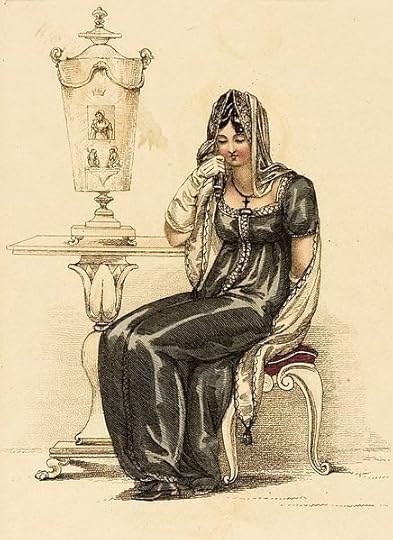
It is probably a fatal sin to have your first P&P variation begin with Elizabeth as a widow. Not Mr Darcy’s widow, of course—that sin may be unforgiveable. But this Elizabeth isn’t the carefree Lizzy Bennet of the original. She is a widow with a past, with current responsibilities, and, in her own mind, no clear future.
To give you an indication of Elizabeth’s marriage before her widowhood, let me start with the Mistress of Netherfield’s opening lines:
It is a truth universally acknowledged that on escaping an unhappy marriage, a young widow will be delighted to remove to the dower house and lease the marital abode to a single man in possession of a good fortune, provided he looks elsewhere to fulfil his want of a wife.
From which you may gather that the widow’s past was not a happy one. Despite this, Elizabeth would spend the first months of her widowhood in mourning. No matter what her feelings were about her dead husband (and relief probably figured in there somewhere), society required she show his memory respect by donning black clothing and secluding herself.
Most of what we think we know about 19th century mourning customs are really those of the later high Victorian period, when, following Queen Victoria’s example after the death of Prince Albert, mourning became almost a life-long vocation. It certainly was for Victoria. By that time, mourning periods were set in stone: a widow wore deepest mourning (that is unrelieved black clothing in dulled, matte fabrics such as crepe or bombazine) for two years, before going into the muted greys and lavenders of ‘half-mourning’. Men, of course, got off more lightly by wearing black gloves and cravats, but then by the Victorian Age, men’s clothes were already so dark and dull, black gloves might even be considered an exciting sartorial change.
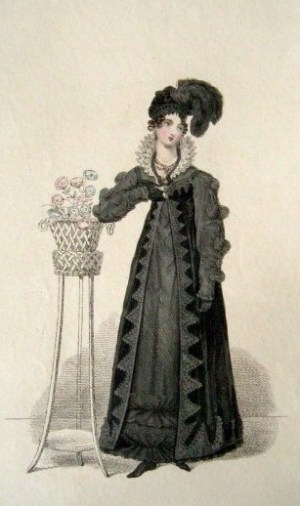
But in the Regency period, mourning was far less prescribed. Widows still tended to remain in a state of mourning for a longish time—up to a year was expected. In the cases where property was involved, the reason for such a long mourning period was because any posthumous child she bore in that time would be decreed by law to be her husband’s, and therefore deemed to be an heir. During that period she could still see her friends and family at quiet, private gatherings and attend church, but she wouldn’t be going to dinners and balls. After 18 months to 2 years, she would likely resume a livelier social life.
Regency fashion plates, such as those from Ackermann’s Repository, include some quite elaborate mourning gowns. Take a look at flounces and furbelows on these:

But unless the family was rich, buying elaborate mourning dresses was a most unlikely extravagance. Most people made do by dyeing existing clothing black, and removing all ornamentation from hats to retrim them with black ribbons and crepe. Jane Austen’s letters to her sister Cassandra several times mention the arrangements they are making to go into mourning. In one, their mother is described as having “…picked her old silk pelisse to pieces, and means to have it dyed black for a gown…” Such thrift was not unusual.
In Mistress of Netherfield, James Grayson had been persuaded (cough! You’ll have to read the relevant chapter to discover the moral pressure put upon him) to leave his unentailed property—that is, Netherfield—in trust to his very young widow, who would have full control over the property when she came of age. Mr Bennet and Mr Philips being the principal trustees, Elizabeth was probably a great deal better off than most young widows in the Meryton area. I like to think that she had one specially-made dress, even if, like most young women, she did dye other dresses while she went through her enforced isolation from society.
I can’t imagine Elizabeth being quite as demure as this young widow, and she will certainly protest at the imposition of a widow’s cap, but I think I’ll allow her a dress this pretty and becoming. It’s rather better than the flounces and furbelows of most of the Ackermann fashion plates, and closer, I suspect, to Elizabeth’s restrained style.
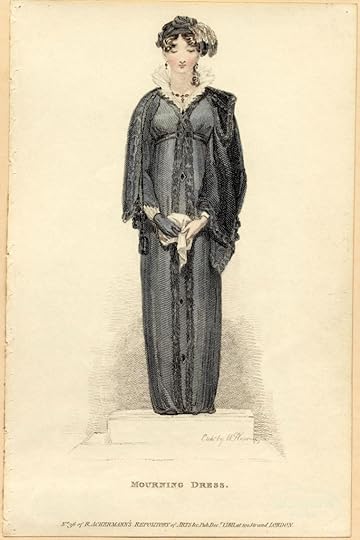
Mistress of Netherfield is published TODAY, 28 June, and is available from an ebook seller near you. Find the bookseller of choice from this link: https://books2read.com/MistressOfNetherfield

PUBLICATION DAY!!!
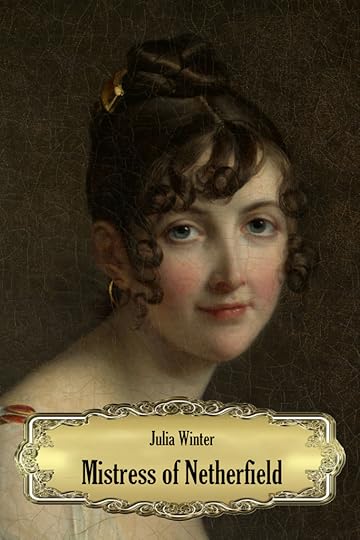 http://www.metmuseum.org/art/collection
http://www.metmuseum.org/art/collectionMistress of Netherfield is published TODAY!
About the bookIt is a truth universally acknowledged that on escaping an unhappy marriage, a young widow will be delighted to remove to the dower house and lease the marital abode to a single man in possession of a good fortune, provided he looks elsewhere to fulfil his want of a wife.
Five years after being forced into an unwanted marriage at the age of sixteen, and freed six months later by the death of her abusive husband, Elizabeth Grayson (née Bennet) has finally found a measure of peace. The inheritor of her husband’s estate, Netherfield Park, Elizabeth is now a wealthy young widow, independent and self-reliant. With an eye always on improving her four sisters’ woefully small dowries and providing for her mother, who will be homeless when her father dies, Elizabeth is pleased to lease out Netherfield to the Bingley family, making her home in the dower house in Meryton and vowing that she will never remarry.
Fitzwilliam Darcy of Pemberley in Derbyshire is rich and well connected, but reserved in company with anybody outside the very few he counts as friends. Towards those friends, he is loyal and steadfast, the staunchest of supporters. So when a young man comes to him with a tale of the clandestine marriage and mysterious death of Darcy’s old schoolfriend, James Grayson, and begs Darcy’s help to investigate the widow’s role, Darcy agrees. Visiting Charles Bingley, the new tenant of Netherfield, Darcy is very soon torn between his loyalty to his dead friend, and his burgeoning attraction to the widow.
Throw two unprincipled rogues and an elopement into the confines of Meryton, and how will Darcy’s dilemma over Elizabeth ever be resolved? And is she willing to put aside her misgivings, and trust again?
(British English spelling and grammar used throughout).
Where to find Mistress of NetherfieldAt Goodreads
Universal link to digital stores: https://books2read.com/
Amazon.com | Amazon.co.uk | Kobo | B&N | Smashwords
Blog Tour StopsNine wonderful Austen bloggers have agreed to host me to help get the word out about Mistress. Here’s the schedule:
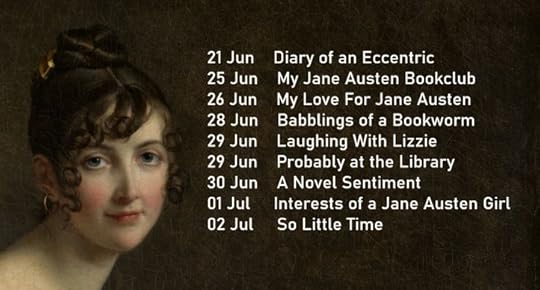

Find me at:
May 27, 2021
Blog Tour Dates Arranged
Mistress of Netherfield will be published on 28 June.
Nine wonderful JA bloggers are hosting me on a release burst tour:

April 14, 2021
Cover Reveal – of sorts!
If you’re going to start blogging, go big. Here’s the probable cover for Mistress of Netherfield. I have no publication date yet, but end May/early June is the most likely.

The detail is from a portrait of Madame Philippe Panon Desbassayns de Richemont (Jeanne Eglé Mourgue, 1778–1855), painted by Marie Guillelmine Benoist in 1802.
The painting is in The Met Fifth Avenue, in Gallery 614, and is available in the public domain for unrestricted use (I’ve cut the detail from the main image and flipped it horizontally). God bless The Met for its generosity!
The Met says: Once attributed to David, this portrait is actually by his pupil, Marie Guillelmine Benoist. David taught a significant number of women artists whose works were made newly visible to the public through the Salon, which prior to the French Revolution had severely restricted submissions by women. This portrait of Jeanne Eglé Fulcrande Catherine Mourgue, called Égle, and her son was probably shown at the Salon of 1802. The sitter’s husband, Philippe Panon Desbassayns de Richemont (1774–1840) enjoyed a successful administrative and diplomatic career under the Consulat, Empire, and Restoration governments.
Sad, isn’t it, that the only information is about the husband, rather than Jeanne herself?
While this image is a little early – like most authors of Pride and Prejudice variations, I’ve set it in 1811/1812) – since I’m just using Jeanne’s head, she makes a perfect Lizzy. Frankly, I’m almost as much in love with this portrait as I am with Lizzy herself.



